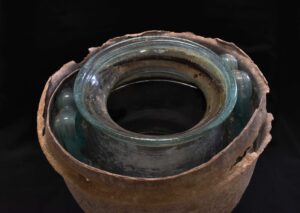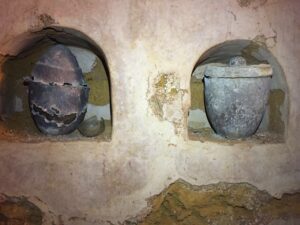Biography
«VINUM VITA EST«: EL VINO DEL MAUSOLEO DE CARMONA
CONTEXTO Y ARQUEOMETRÍA.
Dr. José Rafael Ruiz Arrebola
Departamento de Química Orgánica
Facultad de Ciencias
Universidad de Córdoba
Los estudios realizados hasta la fecha por diferentes grupos de investigación sobre restos de vinos arqueológicos, que se han limitado a las vasijas o a los restos de vasijas que los contuvieron, incluyen la identificación de diferentes biomarcadores de vinos antiguos.
Sin embargo, nunca se ha podido constatar la existencia de un vino de épocas pasadas en estado líquido. En el año 2019, se descubrió en Carmona (Sevilla) una tumba colectiva cuya construcción y uso se ha podido fechar durante la primera mitad del siglo I d. C.
El complejo funerario, cuya tipología corresponde a los denominados mausoleos circulares, contenía los restos óseos cremados de seis individuos adultos, que se habían preservado en sus correspondientes urnas cinerarias. Además, en la cámara se encontraron diversos objetos relacionados con los ajuares y las ofrendas funerarias, así como materiales orgánicos debido a que la cámara subterránea se había preservado sellada herméticamente, permitiendo unas condiciones ambientales favorables para su conservación.
En una de las urnas, fabricada en vidrio y protegida en el interior de una funda de plomo, los restos óseos fueron cubiertos por casi cinco litros de un líquido rojizo, siendo esto un hallazgo excepcional y sorprendente. El estudio arqueoquímico de este líquido ha permitido identificarlo como el vino más antiguo del mundo conservado en estado líquido.
Para ello, se han empleado, por un lado, el plasma acoplado inductivamente-espectrometría de masas (ICP-MS) para la determinación de las sales minerales y, por otro, la cromatografía líquida de alta resolución-espectrometría de masas (HPLC-MS) para la determinación de polifenoles. El perfil de sales minerales y, sobre todo, la detección y cuantificación de una serie de polifenoles característicos nos ha permitido establecer que dicho líquido fue un vino blanco.
‘VINUM VITA EST»: THE WINE OF THE MAUSOLEUM OF CARMONA
CONTEXT AND ARCHAEOMETRY.
Dr. José Rafael Ruiz Arrebola
Department of Organic Chemistry
Faculty of Science
University of Cordoba
The studies carried out to date by different research groups on archaeological wine remains, which have been limited to the vessels or the remains of vessels that contained them, include the identification of different biomarkers of ancient wines.
However, it has never been possible to establish the existence of a wine from past times in a liquid state. In 2019, a collective tomb was discovered in Carmona (Seville), the construction and use of which can be dated to the first half of the 1st century AD.
The funerary complex, whose typology corresponds to the so-called circular mausoleums, contained the cremated skeletal remains of six adult individuals, which had been preserved in their corresponding cinerary urns. In addition, various objects related to grave goods and funerary offerings were found in the chamber, as well as organic materials due to the fact that the underground chamber had been hermetically sealed, allowing for favourable environmental conditions for their preservation.
In one of the urns, made of glass and protected inside a lead cover, the skeletal remains were covered by almost five litres of a reddish liquid, an exceptional and surprising finding. The archaeochemical study of this liquid has made it possible to identify it as the oldest wine in the world preserved in a liquid state.
For this purpose, inductively coupled plasma-mass spectrometry (ICP-MS) was used for the determination of mineral salts and high performance liquid chromatography-mass spectrometry (HPLC-MS) for the determination of polyphenols. The profile of mineral salts and, above all, the detection and quantification of a series of characteristic polyphenols have allowed us to establish that this liquid was a white wine.




